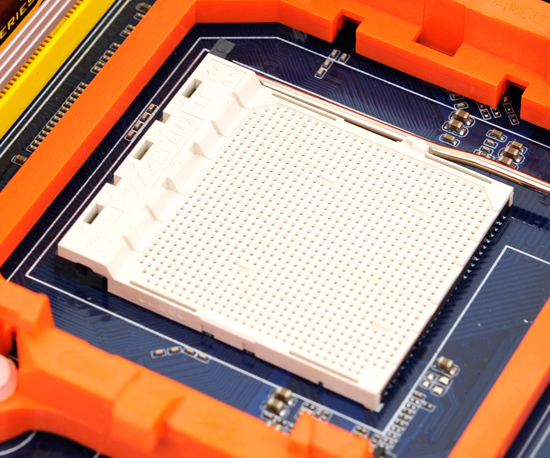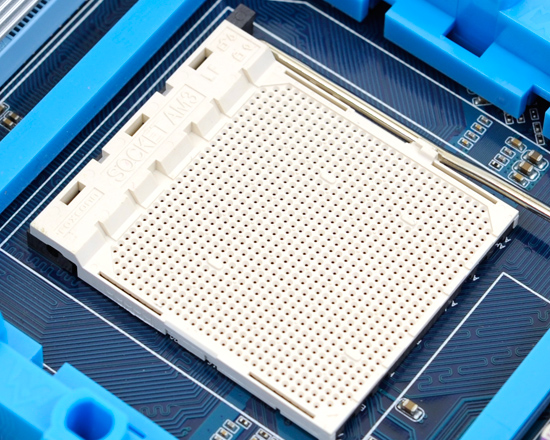AMD's Phenom II X4 955 Black Edition
by Anand Lal Shimpi on April 23, 2009 12:00 AM EST- Posted in
- CPUs
Painfully Backwards Compatible
AMD’s big selling point of its Socket-AM3 processors is that they can still be used in Socket-AM2+ motherboards. In other words, you can use them in DDR3 or DDR2 motherboards. There’s a catch - the Phenom II X4 955 needs a BIOS update to work properly. And guess what? Not all motherboards have that BIOS support yet.
It’s not a major change but the fact of the matter is that AMD and its board partners have not done the work necessary to enable support across the board at launch. That means that if you have a Socket-AM2+ board, you may not be able to run the Phenom II X4 955 just yet.

Socket-AM2+
I ran into this problem with my AM2+ testbed. For the past couple of AMD reviews I’ve used MSI’s DKA790GX Platinum, a 790GX based motherboard. AMD actually sent me the board with my first Phenom II X4 940. Unfortunately it doesn’t have an updated BIOS, so the 955 only runs at 800MHz and won’t POST at 3.2GHz. Great.
The following AM2+ boards currently have support for the 955:
| Motherboard | Socket | Chipset | BIOS Version |
| ASUS M3A79-T Deluxe | AM2+ | AMD 790FX | 20090330 0803 |
| DFI Lanparty DK 790FXB-M2RSH | AM2+ | AMD 790FX | 200900327* |
| ASUS M3A 78-T | AM2+ | AMD 790GX | 20090401 0903 |
| Gigabyte MA790GP-DS4H | AM2+ | AMD 790GX | 20090407 F4* |
And more are coming. AMD suggests that you look at its Motherboard Compatibility page before you pull the trigger if you’re looking to put one of these chips into an older board.

Socket-AM3
Even Socket-AM3 boards will need a BIOS update but those seem a bit more ready to go. Unfortunately because of all of this board switching, some of my 955 numbers aren’t exactly comparable to my older 940 numbers. I’m using different motherboards (Socket-AM3 vs. AM2+) and different memory (DDR3-1333 vs. DDR2-1066). The numbers are close enough, but there were a couple of situations where performance scaled more than it should have or went negative.
Overall it’s not a huge deal but it’s frustrating for anyone looking to save money and upgrade to the 955 but using an older motherboard.










65 Comments
View All Comments
strikeback03 - Thursday, April 23, 2009 - link
Well, the most expensive X58 board is over $400, while the cheapest AM2+ boards are under $50, do you want them to say the range is over $350? I'd guess the thinking behind that statement was that you would pair the most expensive processor AMD sells with a higher-end board - the AMD boards top out at about $190, about where the i7 boards start (ignoring rebates).just4U - Friday, April 24, 2009 - link
It's the minimum entry level into each that I think most people would be curious about. The higher end stuff can really skyrocket the price after all and I am pretty sure it would be filled with features not likely to interest the majority.strikeback03 - Friday, April 24, 2009 - link
Again though, those who are looking to buy the 955 are probably interested in some of the stuff the better boards offer. Considering the performance available form the 720 or 940 at cheaper prices, I am still doubtful how many people would go for the 955 and the cheapest motherboard possible.duploxxx - Thursday, April 23, 2009 - link
arrgghh stupied newegg search engine and no edit on anandtech poststhe msi costs 131, that is still 40$
http://www.newegg.com/Product/Product.aspx?Item=N8...">http://www.newegg.com/Product/Product.aspx?Item=N8...
ssj4Gogeta - Thursday, April 23, 2009 - link
AMD is getting close and that's a good thing as all of us know. Not that I use AMD, but low prices on Intel chips is good.But I think that AMD is soon going to be left behind again when Intel introduces the affordable i5. From what I know the only difference between i7 is that i5 has only 2 channels of RAM and it has the PCIe controller on the package. Surely it won't be too far behind i7 in terms of performance.
Also can someone clarify whether i5 will be using QPI?
duploxxx - Thursday, April 23, 2009 - link
well then you are one of the so many that have an issue about best price/performance and waht about know, all non i7 buyers are better of pricewise with a AMD based system unless you really want to stick with dualcore for no future at all... . On what planet were you living from 2003-2006 when AMD was the better choice of buying instead off Intel.Sagath - Thursday, April 23, 2009 - link
Yes, and No. It uses a QPI derivative called CPI if my memory serves correct.I dont remember where I read this, so I cannot referance you to it. Nor do I know the difference between the two. Sorry.
knutjb - Thursday, April 23, 2009 - link
AMD still has a long way to go but they are improving. I am glad to see them improve since it pressures Intel to lower prices that benefit the majority of us who can't afford Intel's high end. The closer the competition the better for the consumer, we can't afford to see AMD die off as some joke about.Griswold - Thursday, April 23, 2009 - link
"..but as applications and workloads become more threaded the i7 could be a wiser long-term purchase. "I bought my Q6600 in 2007 and for good reasons (then). I made good use of the four cores - but I've been hearing the above quoted sentence sind 2007 and before but it still has not become true and probably wont before quite some time.
Where is this "more threaded" and when will it actually arrive? :P
The situation is such, that I'm definitely going to wait for i5 for the next upgrade and may grab a dualie with hyperthreading, simply because theres only so much I need 4 physical cores for now so it starts to seem like 2 cores plus the two additional logic cores is the more cost efficient and rational way.
An i7 is definitely not going to be my thing - I just dont need 8 logical cores enough to make it worthwhile.
But maybe I can stick to my trusty Q6600 long enough for AMD to serve me the perfect solution, maybe with Bulldozer?
ssj4Gogeta - Thursday, April 23, 2009 - link
Why do you look at the number of cores and decide? Look at the performance numbers and decided.Besides Hyper threading can't deliver performance boost in all applications. So if you're going 2 cores with hyperthreading you may not see as much performance as 4 physical cores in many apps. You need to look at performance numbers for the apps you most use, not the number of cores.